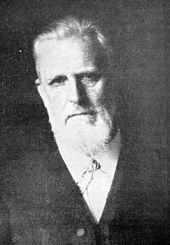Karl Kraut (chemist)
Karl Kraut (also: Karl Johann Kraut ; born September 29, 1829 in Lüneburg , † January 13, 1912 in Hanover ) was a German chemist , professor and expert as well as a secret councilor .
Life
Karl Kraut completed an apprenticeship as a pharmacist in Lübeck and then worked as a pharmacist's assistant for two years. After studying chemistry (1851–1854) in Paris and Göttingen, he received his doctorate “ On derivatives of cuminol and cymene ”. In 1857 he went to the Polytechnic School in Hanover . In 1868 he became a regular professor. When the school moved to the Welfenschloss , he took over the planning of the chemistry rooms. He was also given an official apartment there on the basement floor.
In 1859 Karl Kraut married his first wife Auguste (1834–1880), daughter of the theology professor Johann Georg Reiche . After her death, Kraut married Julie (1850–1929), a daughter of the Hanoverian court painter and professor Carl Oesterley senior and Sophie Murray, the following year . Both of Kraut's marriages remained childless.
In 1882, Kraut took over the management of inorganic chemistry at the now renamed Royal Technical University .
He did his own experimental work, especially in the field of inorganic and analytical chemistry. In the chemical-technical area he worked, among other things, as an expert in the field of waste water from potash processing .
In the 19th century, Karl Kraut was still active several times as an expert against the chemical factory de Haën , against which according to the Hanover history sheets, lawsuits were constantly being initiated.
Herb is best known for his work on Gmelin database , which temporarily as Gmelin-Kraut's manual ... was issued.
On his release in 1895 he was awarded the Order of the Red Eagle III. Class with a bow. His successor in office was Karl Seubert . In 1893 he was elected a member of the Leopoldina .
Karl Kraut married Auguste Reiche (1834–1880) in 1859, daughter of the theologian Johann Georg Reiche . After her death in 1881 he married the daughter Julie (1850–1929) of the painter Carl Oesterley sen. (1805-1891) and thereby also became brother-in-law of the painter Marie Oesterley . Bad health (bronchial disease) he often spent the winters on Capri in the 1890s .
Karl-Kraut-Strasse
Karl-Kraut-Straße in the Hanover district of List , which was laid out in 1892 and leads from Wittekamp to Lister Kirchweg , has since honored the chemist, professor and expert with its name.
Fonts
- Carl Krause , Karl Karmarsch , Wilhelm Krause , Karl Johann Kraut (eds.): Directory of the members and participants of the XL. Meeting of German natural scientists and doctors in Hanover, in 1865 , in this: Official report on the fortieth meeting of German natural scientists and doctors in Hanover in September 1865 , Hahnsche Hofbuchhandlung, 1866, p. 16ff .; Digitized via Google books
literature
- Otto Krätz : Kraut, Karl. In: New German Biography (NDB). Volume 12, Duncker & Humblot, Berlin 1980, ISBN 3-428-00193-1 , p. 722 ( digitized version ).
- Karl Seubert : Karl Kraut † . in: Chemiker-Zeitung 1912, No. 17
- German Biographical Encyclopedia , Vol. 6, p. 86
- Wilhelm Rothert : General Hannoversche Biography (in Gothic script ), Vol. 1: Hannoversche men and women since 1866 ; Hanover: Sponholtz, 1912, p. 352
- Catalogus Professorum , University of Hanover, 1981 ISBN 3-487-13115-3 , p. 160
- Klaus Mlynek : Kraut, Karl Johann. In: Dirk Böttcher , Klaus Mlynek, Waldemar R. Röhrbein, Hugo Thielen : Hannoversches Biographisches Lexikon . From the beginning to the present. Schlütersche, Hannover 2002, ISBN 3-87706-706-9 , p. 211; Preview over google books
Web links
Individual evidence
- ^ Carl Krause, Karl Karmarsch, Wilhelm Krause, Karl Kraut (eds.): Official report on the fortieth meeting of German naturalists and doctors in Hanover in September 1865 , Hahnsche Hofbuchhandlung, 1866, p. 16ff .; Digitized via Google books
- ^ Klaus Mlynek: Kraut, Karl Johann. In: Hannoversches Biographisches Lexikon , p. 211; Preview over google books
- ^ A b c Helmut Zimmermann : Karl-Kraut-Strasse , in ders .: The street names of the state capital Hanover. Verlag Hahnsche Buchhandlung, Hannover 1992, ISBN 3-7752-6120-6 , p. 138
- ↑ n.v . : Kraut, Karl Johann in the database of Niedersächsische Personen ( new entry required ) of the Gottfried Wilhelm Leibniz Library - Lower Saxony State Library in the version of June 25, 2009, last accessed on January 13, 2020
- ↑ Otto Krätz : Kraut, Karl. In: New German Biography (NDB). Volume 12, Duncker & Humblot, Berlin 1980, ISBN 3-428-00193-1 , p. 722 ( digitized version ).
| personal data | |
|---|---|
| SURNAME | Kraut, Karl |
| ALTERNATIVE NAMES | Kraut, Karl Johann (full name) |
| BRIEF DESCRIPTION | German chemist |
| DATE OF BIRTH | September 29, 1829 |
| PLACE OF BIRTH | Luneburg |
| DATE OF DEATH | January 13, 1912 |
| Place of death | Hanover |
